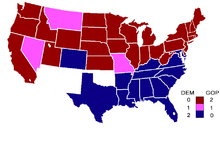59th United States Congress
| 59th United States Congress | |||||||||||||||||||||||||||||
| |||||||||||||||||||||||||||||
The Fifty-ninth United States Congress was a meeting of the legislative branch of the United States federal government, composed of the United States Senate and the United States House of Representatives. It met in Washington, D.C. from March 4, 1905 to March 4, 1907, during the fifth and sixth years of Theodore Roosevelt's presidency. The apportionment of seats in the House of Representatives was based on the Twelfth Census of the United States in 1900. Both chambers had a Republican majority.
Major events
Major legislation
- June 8, 1906: Antiquities Act
- June 29, 1906: Hepburn Act
- June 30, 1906: Pure Food and Drug Act of 1906 (Wiley Act), ch. 3915, 34 Stat. 768
- June 30, 1906: Meat Inspection Act (Beveridge Act)
- 1906: The Carnegie Foundation for the Advancement of Teaching chartered.[1]
- March 2, 1907: Expatriation Act of 1907, 34 Stat. 1228

Party summary
Senate
- Republican (R): 59 (majority)
- Democratic (D): 31
TOTAL: 90
House of Representatives
- Republican (R): 251 (majority)
- Democratic (D): 135
TOTAL: 386

Charles W. Fairbanks
Leaders
Senate
House of Representatives
- Speaker: Joseph G. Cannon (R)
Majority (Republican) leadership
Minority (Democratic) leadership
Members
This list is arranged by chamber, then by state. Senators are listed in order of seniority, and Representatives are listed by district.
Senate
At this time, Senators were elected by the state legislatures every two years, with one-third beginning new six-year terms with each Congress. Preceding the names in the list below are Senate class numbers, which indicate the cycle of their election.
House of Representatives
Employees
- Architect of the Capitol: Elliott Woods, appointed February 19, 1902.
Senate
- Secretary of the Senate: Charles G. Bennett of New York, elected February 1, 1900.
- Sergeant at Arms of the Senate: Daniel M. Ransdell of Indiana, elected February 1, 1900.
- Chaplain of the Senate
- The Rev. Edward E. Hale, Unitarian, elected December 14, 1903.
House of Representatives
- Clerk of the House: Alexander McDowell of Pennsylvania, elected December 4, 1905.
- Sergeant at Arms of the House: Henry Casson of Wisconsin, elected December 4, 1905.
- Doorkeeper of the House: Frank B. Lyon of New York, elected December 4, 1905.
- Postmaster of the House: Joseph C. McElroy of Ohio, elected December 4, 1905.
- Clerk at the Speaker’s Table: Asher C. Hinds
- Chaplain: The Rev. Henry N. Couden, Universalist, elected December 4, 1905.
References
- ↑ "Carnegie Foundation". Carnegie Foundation. November 26, 2011. Retrieved 2011-12-05.
- ↑ Robert M. La Follette was elected to the 59th Congress for the term starting March 4, 1905, but he did not assume the seat until January 2, 1906, preferring to finish his term as Governor of Wisconsin.
- Gould, Lewis L. (2005). The Most Exclusive Club. Cambridge, MA: Perseus Books Group. ISBN 0-465-02778-4.
- Remini, Robert V. (2006). The House. New York: HarperCollins Publishers, Inc. ISBN 0-06-088434-7.
- U.S. Congress (2005). "Biographical Directory of the U.S. Congress". Archived from the original on June 1, 2006. Retrieved June 1, 2006.
- U.S. House of Representatives (2006). "Congressional History". Archived from the original on June 1, 2006. Retrieved June 1, 2006.
- U.S. Senate (2006). "Statistics and Lists". Archived from the original on June 1, 2006. Retrieved June 1, 2006.
| |||||||||||||||||||
